It’s beginning to look a lot like… JN.1 season around the world. The JN.1 COVID variant, a descendant of the very mutated Pirola BA.2.86, continues to skyrocket around the world as it becomes globally dominant. After JN.1 became dominant, hospitalizations spiked significantly in the Ile-de-France (Paris and its suburbs in France) which may be related to the sheer number of people infected. When the JN.1 variant became dominant in Singapore, there was a 500% increase in SARS-CoV-2 viral wastewater levels within three weeks. The updated XBB.1.5 vaccine offers good protection against JN.1 and other circulating variants and can help reduce severe infections and hospitalizations for COVID.
As I was writing this newsletter today, JP Weiland tweeted a new warning, “Witnessing some of these record setting wastewater signals is now MANY European countries after Pirola (JN.1) dominance is eye opening. We have to prepare ourselves for at least the *possibility* that we see a very large spike in the US in coming weeks.“ According to Dr. Wolfgang Hagen on his blog, Austria is seeing extremely high wastewater SARS-CoV-2 levels and this is associated with a large increase in hospitalizations.
On December 14th, the CDC posted a Health Alert Network advisory warning that COVID hospitalizations are quickly rising in the U.S. and there has also been an increase in pediatric multisystem inflammatory syndrome in children (MIS-C) related to COVID infections. Influenza infections are increasing as expected in most of the United States and RSV has peaked, but cases remain high in many parts of the country. Americans are undervaccinated for COVID, Flu and RSV. As of December 2nd, only 17% of adults have received the updated COVID vaccine, 41% had gotten the flu shot and about 16% of adults over age 60 have received a RSV vaccine. The CDC highly recommends getting vaccinated now in order to help reduce severe infections that could land people, including children, in the hospital. Other mitigation methods include wearing N95 or KN95 masks indoors when SARS-CoV-2 virus levels are high, improving air circulation and filtration indoors, testing for COVID before going to a group event, and staying home when sick. These can all help to stop the spread of JN.1 over the holidays.
The CDC reports that early indicators like test positivity (11.5%) and emergency department visits (up 4% this week) are starting to increase and that COVID wave severity indicators like hospitalizations (up 17.6% this week) and deaths (up 25% in the most recent week) are up as well. About 40% of people with COVID infections are asymptomatic and have no symptoms, but they are still contagious and may inadvertently infect others at Christmas parties and New Years celebrations if they do not test before.
Nationally, wastewater SARS-CoV-2 levels are high with the midwest showing the highest activity. We rely on wastewater levels of the virus to track COVID infections now since most cases of COVID are no longer reported. The curves show rapidly increasing COVID infections in all parts of the U.S. now which appear to be due to increases in JN.1.
Last week, Stanford saw an incredibly high amount of SARS-CoV-2 in its wastewater. This blip lasted for about five days before going back down to a virus level more like the wastewater in nearby places. I don’t know why this happened. Could it have been a group of tourists all with COVID infections that visited Stanford for a few days and then left? Was it an error in reporting? We probably won’t find out. Regarding the rest of Santa Clara County, wastewater monitoring shows high levels of virus in the San Jose and Palo Alto sewersheds and medium levels of virus in Sunnyvale and Gilroy wastewater at this time.
When a kid's COVID symptoms go away, are they no longer infectious? A new study shows that half of children are still infectious the day after their COVID symptoms resolve and 40% of kids remain infectious two days after their symptoms go away. The study also showed that 75% of kids were no longer infectious by day 7 after symptom onset and 90% were no longer infectious by 10 days after symptom onset. Therefore, the authors said that their findings support infection prevention and control interventions for up to 10 days.
Rapid antigen tests
Since most people have some immunity to COVID from prior COVID infection and/or COVID vaccination, people tend to get symptoms earlier in the course of the illness now. But often, rapid antigen tests can be negative early in a COVID infection because the viral load has not reached a high enough level yet to be detected by the tests. So, it is very important to repeat rapid antigen tests after a few days to exclude COVID. During that time, it is best to stay at home to avoid infecting others if you have symptoms or if you were exposed to COVID. If a rapid antigen test is positive for COVID, that means that the person’s viral load is high enough for them to be contagious to others, whether or not they have symptoms.
Vaccines
The Ho lab updated their recent preprint which showed that the latest XBB.1.5 mRNA vaccines cause people to make neutralizing antibodies to variants circulating in the U.S. now, including JN.1. They added data regarding prior XBB.1.5 infections and the levels of neutralizing antibodies. A new study from the Netherlands shows that the XBB.1.5 Pfizer vaccine offered adults over age sixty 71% protection against hospitalization and 73% protection against ICU admission from October through December 5, 2023. JN.1 was dominant in the Netherlands at the tail end of this time period.
An exciting new report from Beijing shows that scientists were able to make an inhaled SARS-CoV-2 vaccine in a dry powder form. The inhaled powder was found to go deep into the lower respiratory tract in several animal models (mice, hamsters, and non-human primates) and caused strong mucosal immunity and prevented transmission of all COVID variants tested. Because this vaccine is an inhaled powder, it does not require refrigeration or freezing during transport and it also avoids the use of needles for injection.
In the VROOM trial, for people with autoimmune diseases such as rheumatoid arthritis and psoriatic arthritis who take methotrexate, stopping methotrexate therapy for two weeks after getting a COVID vaccine led to an increased neutralizing antibody response that lasted longer too. A different study showed that vaccination after prior COVID infection improves T cell functions and enhances immunity.
Antiviral treatments
For Paxlovid, if you or your loved one gets COVID, you can check the University of Liverpool COVID drug interaction site: https://www.covid19-druginteractions.org/checker to know which medications might need to be stopped while taking Paxlovid. The medication interaction lists can be printed. To find where you can fill your Paxlovid prescription, the COVID therapeutics finder
https://covid-19-therapeutics-locator-dhhs.hub.arcgis.com/
can let you know where you can get antivirals. Fill in your state and which medication is needed in the dark blue boxes (Therapeutic Selector). I have heard that some insurance companies may require a prior authorization for Paxlovid. It may be worth checking your plan to make sure that this is not the case, as Paxlovid needs to be started within 5 days of COVID infection.
Long COVID
This week, Dr. Ziyad Al-Aly and colleagues came out with another comprehensive study looking at long term consequences of COVID infection versus influenza infection. They studied 81,000 veterans hospitalized with COVID as compared to 11,000 vets hospitalized with influenza. Although the flu can cause long term damage to the respiratory system in a sort of “Long Flu”, COVID was found to be a multi-organ disease that could damage many organ systems leading to significant chronic health problems.
Both COVID and seasonal influenza infections showed a higher burden of health loss months after the acute infection. As compared to people who were hospitalized for influenza, veterans admitted to the hospital for COVID infections had significantly higher rates of death, healthcare utilization, disability, hospital readmission, ICU care and negative health outcomes in 9 out of 10 organ systems (cardiovascular, coagulation and hematological, fatigue, gastrointestinal, kidney, mental health, metabolic, musculoskeletal, neurological) in the 18 months after infection. “We trivialize COVID infections at our peril,” says Al-Aly. “The objective evidence is clear, whether it is a first infection or reinfection, COVID is still a serious threat to human health.”
Regarding this study, @DcrInYYC brought up several good points. On a per incident basis, COVID is more detrimental to long term health than the flu. Adults tend to get influenza infections once or twice per decade, but many people are getting COVID infections once or twice each year. Reinfections with COVID increase risks for long term damage and for Long COVID. Frequent COVID infections can have both personal and societal repercussions.
Two must-read essays about Long COVID were featured in the New York Times this week. Giorgia Lupi has had Long COVID for 1,374 days. As she said, "Long Covid is a physical affliction, but chronic illness, stretching over months and years, has a way of picking apart your mind and breaking your heart.” As a graphic designer and data visualizer, she showed how her Long COVID symptoms progressed over time. “Even if my body, from the outside, resembles the old me, long Covid has rewritten my core personhood on a cellular level."
Journalist Ed Fong wrote about how interviewing with people suffering from Long COVID helped him to become a better journalist. “I witnessed almost every publication that I once held in esteem become complicit in normalizing a level of death once billed as incalculable. It was galling, crushing work that wrecked my faith in journalism and its institutions. But the solace that many long-haulers drew from my pieces gave me solace in turn.” “Around the world, tens of millions of people are suffering from long Covid. Some might recover but most long-haulers don’t fully return to their previous base line. At the same time, the pool of newly sick people will continue to grow…”
A new study in JAMA of 6,932 US families shows that Long COVID, and to a lesser extent prior severe COVID infection, were associated with increased odds of economic hardship for families. People with Long COVID often cannot work as they could before they got COVID and therefore have lost earnings and financial difficulties.
On December 7th to 9th, there was an international conference in Madrid, Spain called “Demystifying Long COVID”. There were many interesting abstracts about the latest research on Long COVID including these two that showed ongoing SARS-CoV-2 viral replication in people with Long COVID.
An oral presentation from Van Weyenbergh of Belgium (page 4, O02) entitled “Blood Transcriptomics Reveal Persistent SARS-CoV-2 RNA And Candidate Clinical Biomarkers in A Belgian Long COVID (LC) Cohort” showed increased antisense RNA which suggests ongoing viral replication. “Summarizing these 800 transcripts into biological pathways, we found significantly decreased TLR signaling (p=0.0039), lymphocyte activation (p=0.016) and immunometabolism (p=0.023) in LC patients. Moreover, immunometabolism was negatively correlated with blood viral load (R=-0.56, p<0.0001), suggesting an “exhausted” immune status in LC due to ongoing viral replication.”
Morgane Bomsel’s lab from Paris showed (page 32, P28) that there was “Persistence of SARS-CoV-2 in Platelets and Megakaryocytes in Long COVID”. “In all samples analyzed, circulating megakaryocytes (MK) in Long COVID sheltered both Spike and SARS-CoV-2 ssRNA, but also dsRNA suggestive of viral replication.” They concluded: “In patients developing Long COVID, SARS-CoV-2 persists and replicates in MKs that in turn produce platelets containing virus…The presence of the virus could lead to abnormal platelet activation and the formation of microclots, which would contribute to the various symptoms observed in long-onset COVID and to deregulation of serotonin uptake, contributing to the neurocognitive symptoms observed in long-onset COVID.”
Dr. Fen Van Rhijn and Jon-Ruben Van Rhijn live-tweeted many of the talks from the Demystifying Long COVID conference which can be found here including:
Long COVID and Vascular Dysfunction by Resia Pretorius
Neuropathogenesis of Long Covid by Selena Spudich MD
Pathogenesis of Long COVID, Decreased mitochondrial function and myopathy by Brent Appelman (looking at skeletal muscles, PEM, in Long COVID patients)
Paxlovid for treatment of Long COVID by Upi Singh MD, Stanford
Brent Appelman’s talk above shows skeletal muscle severe exercise-induced myopathy and metabolic changes are key characteristics of Long COVID and post-exertional malaise (PEM). A group from Berlin reported this week that in 11 Long COVID patients with post-exertional malaise, skeletal muscle biopsies showed fewer capillaries, thicker capillary basement membranes and increased numbers of CD169+ macrophages. They hypothesize that the initial SARS-CoV-2 infection “may have caused immune-mediated structural changes of the microvasculature” in the muscles of people with Long COVID.
Post-acute COVID can cause over 200 different symptoms including trouble with speech and communication after COVID infection. This week, the Royal College of Speech and Language Therapists (RCSLT) published resources including speech and language therapist guidance and patient information for Long COVID patients with speech, swallowing, dysphonia, and communication issues.
A retrospective survey looked at 7000 athletes from 18 different U.S. colleges from Spring 2020 to Fall 2021. It showed that 4% of college athletes had developed Long COVID. Of note, none of the vaccinated athletes studied had Long COVID.
UCSF presented their end-of-the-year update on Long COVID, featuring Dr. Michael Peluso, Dr. Ziyad Al-Aly, Dr. Akiko Iwasaki and moderated by Dr. Bob Wachter. The UCSF Department of Medicine tweeted about the speakers and their research on Long COVID.
Regarding funding for Long COVID clinical trials, the NIH Budget Director announced that RECOVER has secured an additional $200 million from pandemic funds for a second round of clinical trials.
In non-COVID news, a new study shows that the severity of nausea and vomiting of pregnancy (NVP) is the result of the interaction of fetal derived GDF15 hormone and the mother’s sensitivity to this peptide, which is determined by her prior exposure. The authors said that these findings may help with treatment and prevention of Hyperemesis Gravidarum in the future.
Ovarian cancer is usually found at a very late stage because there have been no reliable ovarian cancer detection tests. A new study shows that adding EVA (Early oVArian cancer) test that measures genome instability with copy number profile abnormality (CPA) to routine cervical pap smear tests can detect aggressive ovarian cancer up to nine years before its clinical diagnosis with a sensitivity of 75%, specificity of 96%, and with an accuracy of 81%.
Have a good rest of your weekend,
Ruth Ann Crystal MD
COVID news:
US Variant tracker: https://covid.cdc.gov/covid-data-tracker/#variant-proportions
CDC COVID data tracker: https://covid.cdc.gov/covid-data-tracker/index.html#datatracker-home
CDC COVID Hospitalizations (blue) and Emergency Room (orange) visits tracker: https://covid.cdc.gov/covid-data-tracker/index.html#trends_weeklyhospitaladmissions_7dayeddiagnosed_00
Weekly ED visits for respiratory illnesses, by age and disease: https://www.cdc.gov/ncird/surveillance/respiratory-illnesses/index.html
US Wastewater Monitoring:
NEW CDC wastewater reporting: https://www.cdc.gov/nwss/rv/COVID19-nationaltrend.html
and
CDC wastewater map: https://www.cdc.gov/nwss/rv/COVID19-currentlevels.html
Biobot: https://biobot.io/data/
Wastewater SCAN: https://data.wastewaterscan.org/
California statewide view https://buff.ly/3YObiul
Sewer Coronavirus Alert Network (SCAN) project by Stanford University:
Santa Clara county wastewater: https://covid19.sccgov.org/dashboard-wastewater
Marin county: https://coronavirus.marinhhs.org/surveillance
Mask bloc San Jose, CA: https://masksanjose.org/
Free masks to those who need them
CDC US Respiratory vaccination trends: https://www.cdc.gov/respiratory-viruses/data-research/dashboard/vaccination-trends-adults.html
17% COVID vaccine
40.8% Flu shot
15.9% RSV vaccine for age 60+
JP Weiland updates: https://twitter.com/JPWeiland
https://twitter.com/JPWeiland/status/1734373314099892644
“December 11th Update:
Biobot downgraded last week's signal to 815k. WW is still rising, though stuttering a bit this week, as we've seen in early Dec in past years.
870,000 new infections/day
1 in every 380 became infected today
1 in every 38 people currently infected
photo credit: Via Violet Blue, “A very COVIDY Christmas” from the John Snow Project on YouTube
Austrian hospitals are packed with COVID cases from JN.1 per Wolfgang Hagen MD of Austria:
Update: The current infection situation, a press conference on air hygiene and the Swedish Way in a panel discussion https://buff.ly/3GGLatb
German translated by Google to English
Update: Die derzeitige Infektionslage, eine Pressekonferenz zur Lufthygiene und der Schwedische Weg in einer Podiumsdiskussion
Variants
WARNING from JP Weiland on 12/16/23:
12/14/23 CDC Health Alert Network advisory was posted warning that COVID hospitalizations are quickly rising and there has also been an increase in pediatric multisystem inflammatory syndrome in children (MIS-C) related to COVID infections. Influenza infections are increasing as expected in most of the United States and RSV has peaked but cases remain high in many areas of the country.
Americans are undervaccinated for COVID, Flu and RSV. The CDC highly recommends getting needed vaccines now in order to help reduce severe infections that could land people, including children, in the hospital.
Social
Acute COVID infection
12/12/23 Annals of Internal Medicine: Replication-Competent Virus Detected in Blood of a Fatal COVID-19 Case https://buff.ly/4axs5aD
Our case proves that replication-competent SARS-CoV-2 can traffic in blood during COVID-19 and seed tissues throughout the body.
Pediatrics
12/12/23 CIDRAP: COVID study: 40% of children still infectious after symptom resolution https://buff.ly/3RElu6B
12/12/23 Clinical Infectious Diseases: Viral dynamics of the SARS-CoV-2 Omicron Variant in Paediatric Patients; A prospective cohort study https://buff.ly/3Trfob5
Among 101 children aged 2 to 17 years, they were no longer infectious by:
Median time 5 days after symptom onset
75% by 7 days
90% by 10 days.
When the kids no longer had symptoms,
51% were still infectious the next day after symptom resolution
40% were still infectious 2 days after symptom resolution.
Rapid antigen tests (RAT) tests were often negative early in the course of illness and should not be relied on to exclude infection.
“These findings support the consideration for infection prevention and control interventions for up to 10 days.”
Vaccines
12/6/23 Updated BioRxiV (Ho lab): XBB.1.5 monovalent mRNA vaccine booster elicits robust neutralizing antibodies against emerging SARS-CoV-2 variants https://buff.ly/3GLcgzi
The updated monovalent mRNA vaccine (XBB.1.5 MV) boosted serum virus-neutralization antibodies significantly against not only XBB.1.5 (27.0-fold) and the currently dominant EG.5.1 (27.6-fold) but also key emergent viruses like HV.1, HK.3, JD.1.1, and JN.1 (13.3-to-27.4-fold).
In individuals previously infected by an Omicron subvariant, serum neutralizing titers were boosted to highest levels (1,504-to-22,978) against all viral variants tested.
12/13/23 Early COVID-19 vaccine effectiveness of XBB.1.5 vaccine against hospitalization and ICU admission, the Netherlands, 9 October - 5 December 2023 https://buff.ly/489NYuE
In the Netherlands, the 2023 seasonal COVID-19 vaccination campaign started on October 2, 2023 targeting persons aged 60 years and older, healthcare workers, pregnant women and medical high risk groups using the monovalent XBB1.5 Comirnaty (Pfizer) vaccine.
High level of protection of the 2023 XBB.1.5 Covid vaccine against current circulating variants from the Netherlands in people aged 60 and over.
71% protection against hospitalization
73% protection against ICU admission
12/13/23 Nature (Beijing): Inhaled SARS-CoV-2 vaccine for single-dose dry powder aerosol immunization https://buff.ly/47XWMUq
Inhalable, single-dose, dry powder aerosol SARS-CoV-2 vaccine induces potent systemic (IgG and T cells) and mucosal immune responses (IgA) in mice, hamsters and nonhuman primates for strong mucosal immunity and prevention of transmission with all variants.
12/13/23 Nature: A next-generation inhalable dry powder COVID vaccine https://buff.ly/41rxTye
Current injectable COVID-19 vaccines require refrigeration for manufacture, transport and final storage and administration. They are unable to induce robust immunity in the mucosal tissues lining the airways.
Ye et al. report a vaccine formulation that is not only able to induce respiratory mucosal immunity after local lung delivery, but is also inhaled as a dry powder — avoiding the need for cold chains and the use of needles.
The inhaled powder also goes deep into the lungs in the lower respiratory tract (LRT) as well as the upper respiratory tract (URT).
12/12/23 Lancet Rheumatology: Effect of a 2-week interruption in methotrexate treatment on COVID-19 vaccine response in people with immune-mediated inflammatory diseases (VROOM study): a randomised, open label, superiority trial https://buff.ly/3RHeOEX
For people with autoimmune diseases such as rheumatoid arthritis and psoriatic arthritis, stopping methotrexate therapy for two weeks after giving a COVID vaccine led to an increased neutralizing antibody response that lasted longer.
12/8/23 Science Immunology: SARS-CoV-2 vaccination enhances the effector qualities of spike-specific T cells induced by COVID-19 https://buff.ly/48ieJwI
Vaccination after prior COVID infection improves T cell functions and enhances immunity.
Antiviral treatments
FYI- Some insurance companies are requiring people to get prior authorization before getting Paxlovid! I don't know if people will be able to get it in time.
You can look up medication interactions with COVID medications like Paxlovid on the University of Liverpool COVID drug interaction site: https://www.covid19-druginteractions.org/checker
You can print out the list of meds and if they interact with Paxlovid or not.
Here is the Paxlovid Rx finder
https://covid-19-therapeutics-locator-dhhs.hub.arcgis.com/
You have to fill in your state and which medication is needed in the dark blue boxes (Therapeutic Selector) which was not obvious to me.
6/12/23 Medscape: COVID-19 Treatment: Investigational Drugs and Other Therapies: Introduction, Antiviral Agents, Immunomodulators and Other Investigational Therapies https://buff.ly/3uR7mhs
Summary from June 2023 re: different medications being trialed for acute COVID infections.
Long COVID
12/11/23 Prevalence of covid-19 and long covid in collegiate student athletes from spring 2020 to fall 2021: a retrospective survey - BMC Infectious Diseases https://buff.ly/48eOp6A
18 colleges studied with 7000 athletes showed that 4% of college athletes developed Long COVID.
None of the vaccinated athletes had Long COVID.
Photo: Roger Smith on Flicker
12/14/23 UCSF end of the year update on Long COVID, featuring Dr. Michael Peluso, Dr. Ziyad Al-Aly, Dr. Akiko Iwasaki and moderated by Dr. Bob Wachter
as tweeted by UCSF Department of Medicine: https://twitter.com/UCSFDOM/status/1735389012339421245
12/14/23 https://twitter.com/Dakota_150/status/1735325502871626031
Shared from NIH ACD Meeting this morning, courtesy of a LC patient advocate - Neil Shapiro, NIH Budget Director announced that RECOVER has secured an additional $200 million from the pandemic funds [the supplemental appropriations] for a second round of clinical trials.
12/14/23 Lancet Infectious Diseases (Z. Al-Aly) Long-term outcomes following hospital admission for COVID-19 versus seasonal influenza: a cohort study https://buff.ly/3RFXPmn
18 months after hospitalization.
Compared to seasonal influenza, hospital admission for COVID-19 was associated with higher long-term risks of death and adverse health outcomes in nearly every organ system (except for the lungs) and significant cumulative excess disability-adjusted life-years (DALYs) than hospital admission for seasonal influenza.
Figure 4:
B) Disability-adjusted life-years (DALYs) per 100 persons presented for the COVID-19 (red) and seasonal influenza (blue) groups in each organ system.
(C) Event rates per 100 persons presented for COVID-19 (red) and seasonal influenza (blue).
(D) DALYs per 100 persons presented for COVID-19 (red) and seasonal influenza (blue).
Thread from Dr. Ziyad Al-Aly on this study:
https://twitter.com/zalaly/status/1735444944070885868
Long-term outcomes of people hospitalized for COVID-19 vs seasonal influenza.
The study included:
81,280 individuals hospitalized for SARS-CoV-2
10,985 individuals hospitalized for seasonal influenza
Covid had higher risk of death, healthcare utilization and sequelae in most organ systems than flu. Risks were higher in Covid for all organ systems except for the pulmonary system which was higher in flu.
Covid is more multisystemic than flu. Flu is more respiratory than Covid.
Both COVID-19 and seasonal influenza had a higher burden of health loss in the post-acute phase of infection compared to their respective acute phases, but loss was higher for COVID.
12/14/23 Fortune: COVID-19 v. Flu: A ‘much more serious threat,’ new study into long-term risks concludes https://buff.ly/471jUQT
Review of Dr. Al-Aly and colleagues study showing that as compared to people who were hospitalized for Influenza, veterans admitted to the hospital for COVID infections had significantly higher rates of death, healthcare utilization, hospital readmission, ICU care and adverse health outcomes in 9 out of 10 organ systems than did patients with the flu.
“COVID is really a multi-systemic disease, and flu is more a respiratory virus.” said Dr. Al-Aly.
“Conceptualizing the illness as an acute event obscures the much larger burden of health loss that occurs later.”
COVID-19 poses a much higher risk, both in the short run and long term, than flu. But the flu remains “a formidable foe,” Al-Aly says.
“We trivialize COVID infections at our peril,” says Al-Aly. “The objective evidence is clear, whether it is a first infection or reinfection, COVID is still a serious threat to human health.”
12/14/23 NY Times by Giorgia Lupi: 1,374 Days: My Life With Long Covid https://buff.ly/47O2jNn
"Long Covid is a physical affliction, but chronic illness, stretching over months and years, has a way of picking apart your mind and breaking your heart.”
“Even if my body, from the outside, resembles the old me, long Covid has rewritten my core personhood on a cellular level."
"Long Covid runs the show now. I know from experience that if I overdo it in any way, which can mean taking actions as small as sitting up for too long or trying to make the bed, I could make myself feel far worse, shrinking the tiny life I have left into something even smaller."
12/11/23 NY Times by Ed Yong: Reporting on Long Covid Taught Me to Be a Better Journalist https://buff.ly/3uOrNvl
"This piece is sort of a manifesto for a journalism grounded in compassion, rigor, and care."
“Around the world, tens of millions of people are suffering from long Covid. Some might recover but most long-haulers don’t fully return to their previous base line. At the same time, the pool of newly sick people will continue to grow…”
“I witnessed almost every publication that I once held in esteem become complicit in normalizing a level of death once billed as incalculable. It was galling, crushing work that wrecked my faith in journalism and its institutions. But the solace that many long-haulers drew from my pieces gave me solace in turn.”
12/12/23 JAMA: COVID-19 Symptoms (Long COVID) and Economic Hardship Among US Families https://buff.ly/48gZ7tr
Cohort study of 6932 families
Long COVID (persistent COVID-19 symptoms), and to a lesser extent previous severe COVID-19, were associated with increased odds of pandemic-related economic hardship in a cohort of US families.
12/8/23 Acta Neuropathologica Communications: Post-COVID exercise intolerance (Long COVID, ME/CFS type) is associated with capillary alterations and immune dysregulations in skeletal muscles https://buff.ly/3teNk00
Skeletal muscle biopsies obtained from 11 patients suffering from enduring fatigue and post-exertional malaise after an infection with SARS-CoV-2 vs. historical controls.
The skeletal muscles of patients with post-COVID exertion intolerance had:
fewer capillaries
thicker capillary basement membranes
increased numbers of CD169+ macrophages.
No SARS-CoV-2 RNA was detected in muscle biopsies.
Complement system related proteins were more abundant in the serum of patients with PCS, matching observations on the transcriptomic level in the muscle tissue.
We hypothesize that the initial viral infection may have caused immune-mediated structural changes of the microvasculature, potentially explaining the exercise-dependent fatigue and muscle pain.
For speech and language therapists and others to help Long COVID patients with speech, swallowing, dysphonia, and communication issues:
https://www.rcslt.org/news/new-long-covid-guidance-and-patient-handbook/
Demystifying Long COVID conference Dec 7-9, 2023 in Spain.
Abstracts can be found here:
h/t Siebe:
Dr. Fen Van Rhijn and Jon-Ruben Van Rhijn live-tweeted many of the talks from the Demystifying Long COVID conference which can be found here including:
Long COVID and Vascular Dysfunction by Resia Pretorius
Neuropathogenesis of Long Covid by Selena Spudich MD
Pathogenesis of Long COVID, Decreased mitochondrial function and myopathy by Brent Appelman (looking at skeletal muscles, PEM, in Long COVID patients)
Stanford’s 15 day Paxlovid study for Long COVID by Upi Singh MD
Q&A for Dr. Upi Singh:
Q: why only 15 days (of Paxlovid) given
A: the drug was under emergency authorization etc, lots of safety concerns
Q: evidence that paxlovid works against viral persistence
A: they found gut reservoirs 7 months after infection. Don't know yet if it helps against gut colonization yet.
Q: did they notice paxlovid rebound effects?
A: the study hasn't been unblinded yet. People feel a lot better overall. They get more tlc than in regular care. Some people had symptoms come back. That's why they had the long time point.
Dec 2023 CDC Myalgic Encephalomyelitis/Chronic Fatigue Syndrome (ME/CFS) in Adults: United States, 2021–2022 https://buff.ly/3NiiTMX
Billboards for Long COVID awareness in several countries
“NietHersteld is an activist group that shows which people we miss in society because they have not recovered. #LongCovid & other post-infectious conditions.”







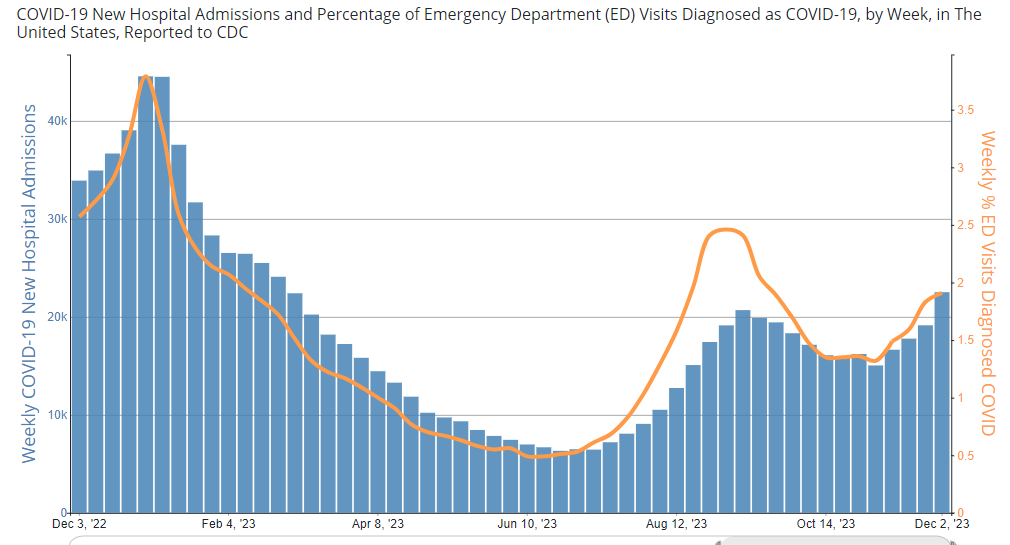
















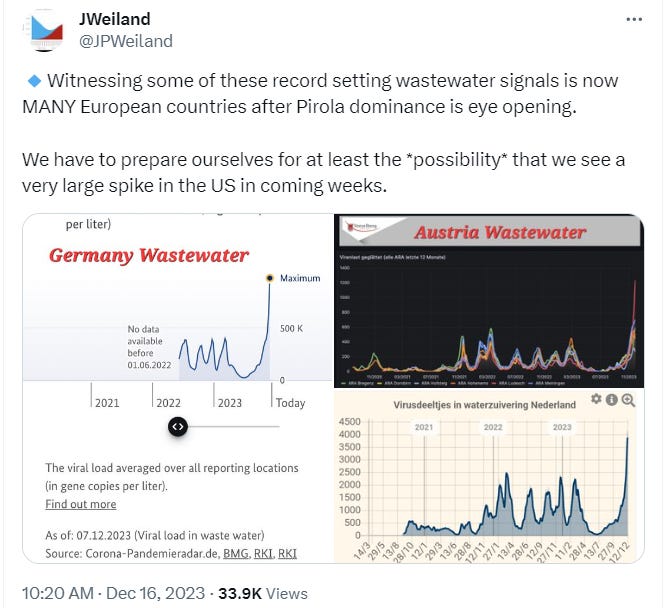

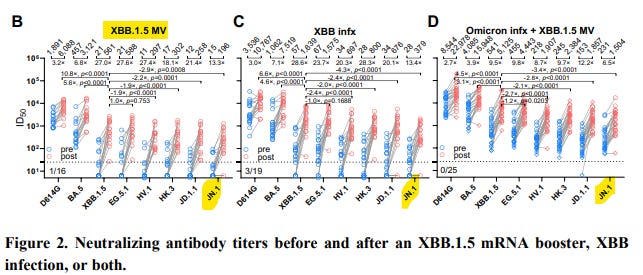









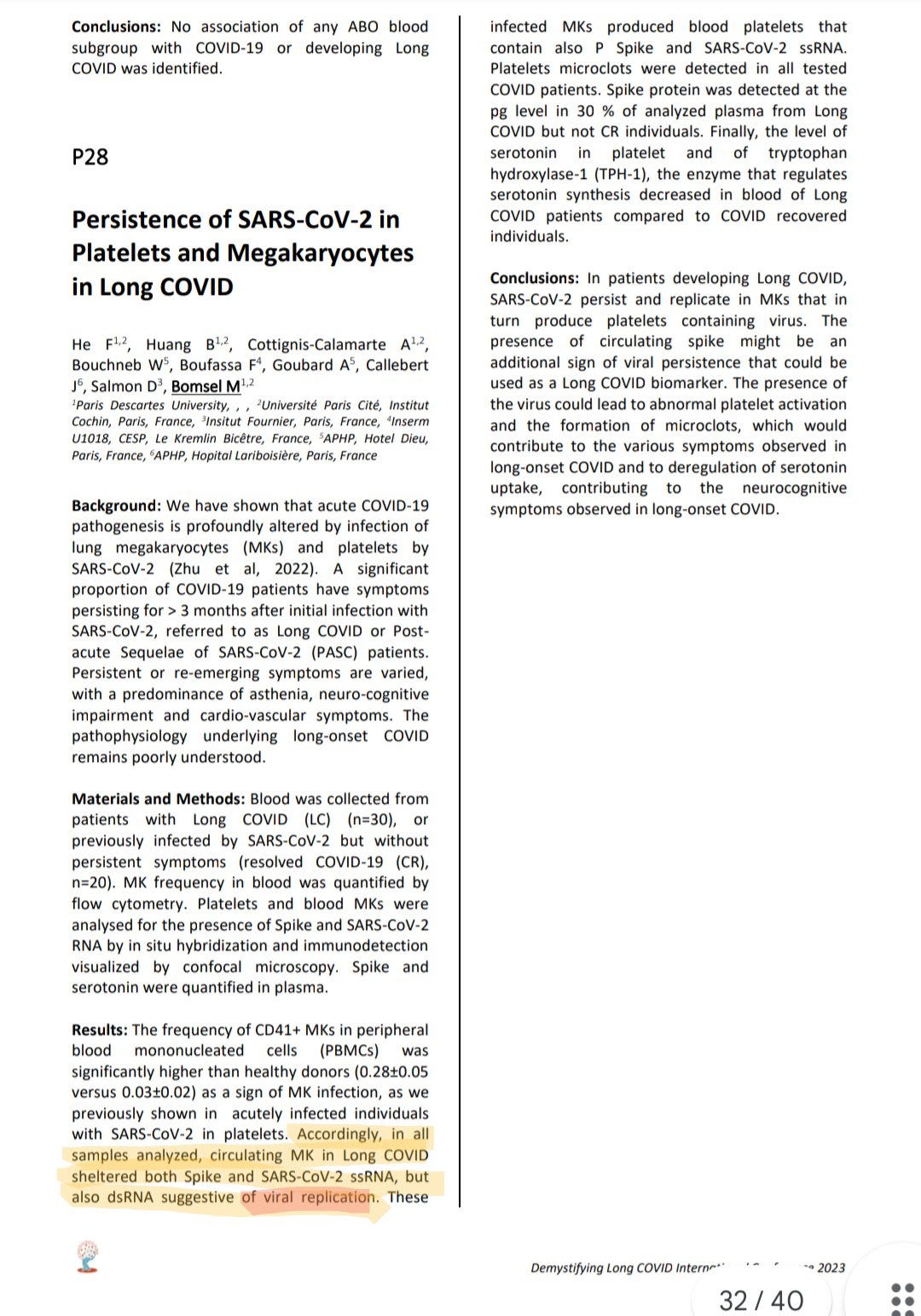
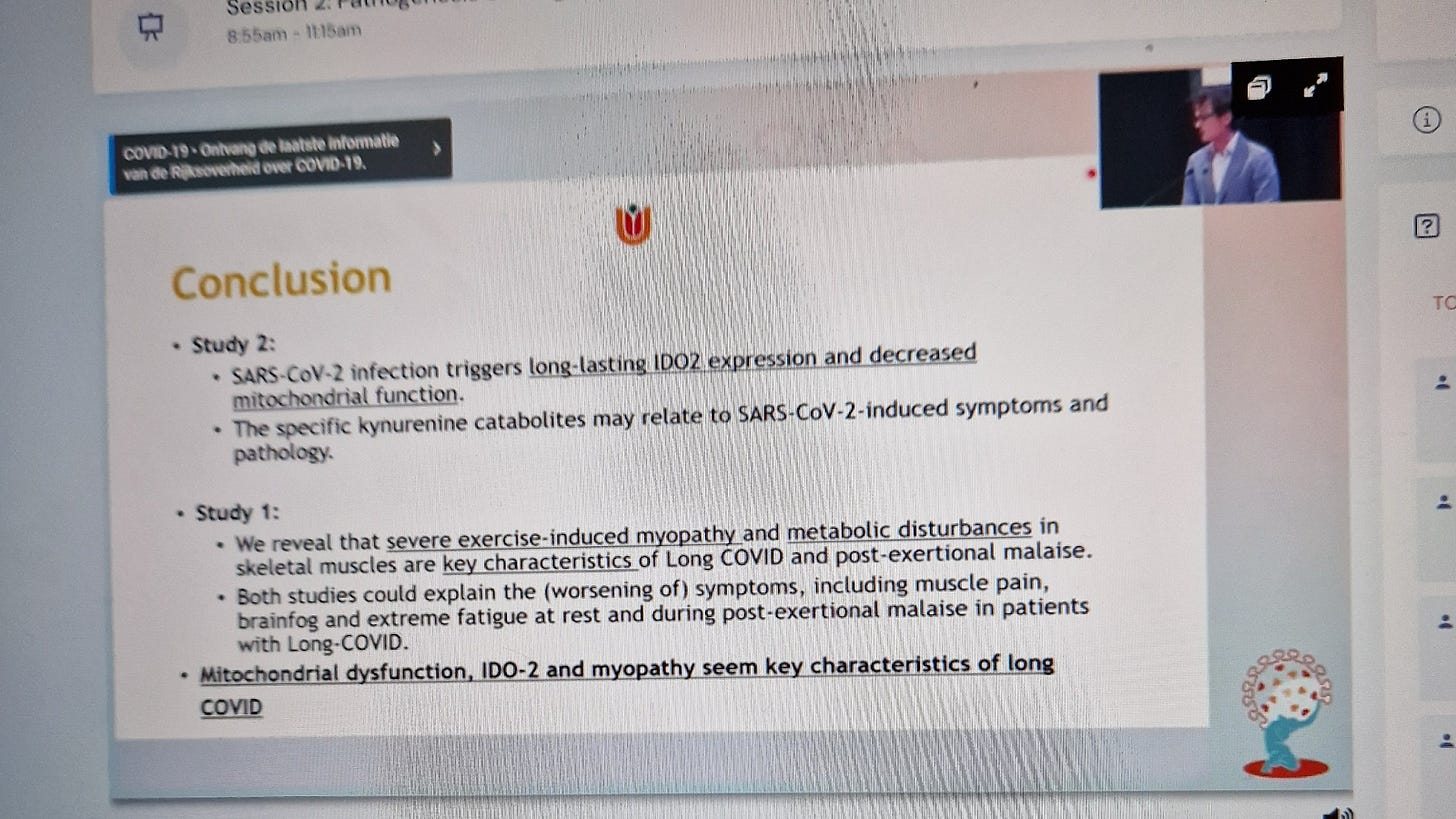


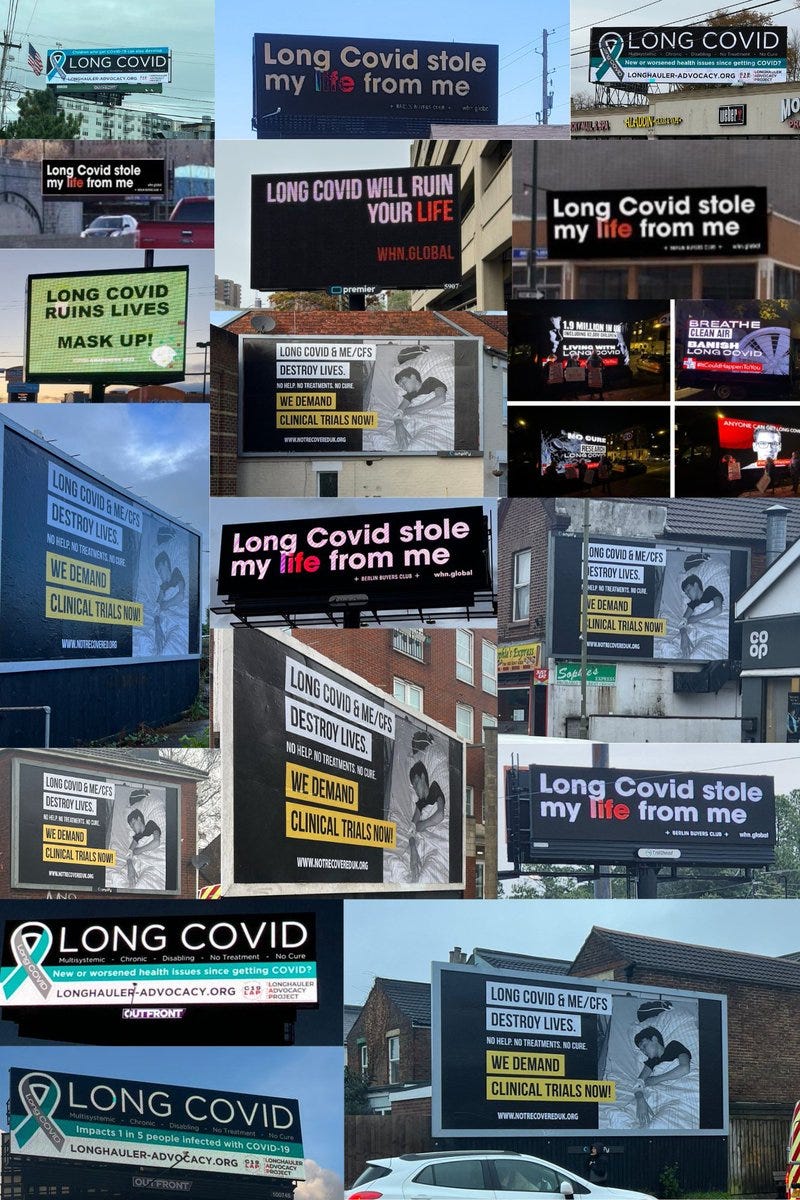


Hi Dr. Crystal! Love your newsletter every week. What was your source on the MIS-C? Sorry if I missed it in the text. Thanks, Andrea (former patient 🤱🏻and currently working on MIS-C)
Thanks so much for your work. This is an amazing wealth of information. You've covered everything we need to know. I appreciate it very much.